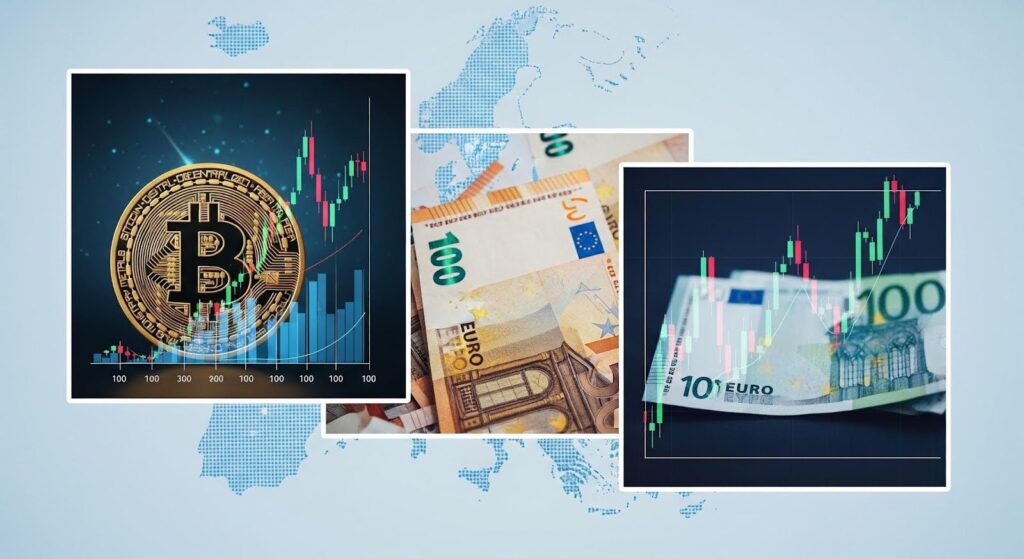The relationship between cryptocurrency assets and traditional monetary systems has become increasingly significant as European investors seek alternatives to protect their wealth from inflationary pressures, with Bitcoin price movements serving as a critical indicator for those evaluating digital assets as inflation hedges. As the Eurozone navigates complex monetary policy decisions and inflation management strategies, Bitcoin’s role as a potential hedge against currency debasement and rising prices has attracted considerable attention from both institutional and retail investors across Europe.
The European Central Bank’s ongoing monetary policy adjustments, combined with projected inflation rates and currency dynamics, create a compelling backdrop for analyzing Bitcoin’s effectiveness as an inflation protection mechanism compared to traditional Euro-denominated assets and savings vehicles.
Current Eurozone Inflation Landscape and Monetary Policy Context
The European Central Bank maintains confidence in achieving its medium-term inflation target throughout 2025, with headline inflation expected to reach the 2% target sustainably during 2025. Recent ECB projections indicate a complex inflation trajectory, with inflation projected to average 2.0% in 2025 and then 1.6% in 2026, before returning to 2.0% in 2027.
The current monetary environment reflects measured policy adjustments, as interest rates on the deposit facility, main refinancing operations, and marginal lending facility were decreased to 2.75%, 2.90%, and 3.15%, respectively, with effect from February 5, 2025. These policy decisions directly impact the Euro’s purchasing power and create conditions that influence investor behavior toward alternative assets.
The inflation outlook remains subject to significant uncertainty, with the December Eurosystem staff projections expecting inflation to average 2.1% in 2025, while the economic outlook for the euro area remains weak and subject to significant uncertainty. This uncertain environment amplifies the appeal of alternative inflation hedges for risk-conscious investors.
Bitcoin’s Empirical Performance as an Inflation Hedge
Recent academic research provides compelling evidence for Bitcoin’s effectiveness as an inflation hedge. Based on monthly data between August 2010 and January 2023, results indicate that bitcoin returns increase significantly after a positive inflationary shock, corroborating empirical evidence that Bitcoin can act as an inflation hedge. This empirical foundation supports the theoretical arguments for Bitcoin’s inflation-hedging properties.
The fundamental characteristics that support Bitcoin’s inflation hedge thesis center on its finite supply mechanism. Bitcoin is often seen as a hedge against inflation because only 21 million bitcoins will ever exist—no more can be created. This scarcity principle directly contrasts with fiat currencies that can be created through central bank monetary policy decisions.
However, the relationship between Bitcoin and inflation is nuanced and evolving. In 2025, gold has outperformed Bitcoin in terms of year-to-date gains, reinforcing gold’s status as a traditional inflation hedge, though Bitcoin’s growing institutional adoption and potential for high returns continue to attract investors. This comparison highlights the importance of evaluating Bitcoin within the broader context of inflation hedge alternatives.
Comparative Analysis with Euro-Denominated Assets
The effectiveness of Bitcoin as an inflation hedge must be evaluated against traditional Euro-denominated alternatives, including government bonds, real estate, and equity investments. European investors face unique challenges as ECB monetary policy directly influences the purchasing power of Euro-denominated savings and investments.
Traditional inflation hedges in the Eurozone include government inflation-linked bonds, real estate investments, and commodity-linked securities. However, these assets often carry exposure to European economic conditions and monetary policy decisions that may not provide adequate protection during periods of coordinated global monetary expansion.
Bitcoin’s global nature and independence from any single monetary authority potentially offer diversification benefits that traditional Euro-denominated assets cannot provide. The cryptocurrency’s performance correlation with European inflation rates and monetary policy decisions differs significantly from conventional hedging instruments.
Institutional Adoption and Market Recognition
The evolution of Bitcoin’s role in institutional portfolios reflects growing recognition of its hedging potential. Macroeconomic forces now heavily influence both Bitcoin and Ethereum, with Bitcoin seen as an inflation hedge, while both assets are discussed not just in crypto circles but in central bank briefings and institutional portfolios. This institutional recognition validates Bitcoin’s emergence as a legitimate asset class for inflation protection strategies.

The integration of Bitcoin into traditional financial infrastructure, including exchange-traded funds and institutional custody solutions, has improved accessibility for European investors seeking inflation protection through cryptocurrency exposure.
Risk Factors and Volatility Considerations
While Bitcoin demonstrates inflation-hedging characteristics, investors must consider its volatility profile compared to traditional hedging instruments. Bitcoin’s price movements can be significantly more dramatic than conventional inflation hedges, creating both opportunities and risks for investors seeking stable purchasing power protection.
The cryptocurrency’s correlation with risk assets during market stress periods can temporarily diminish its effectiveness as a hedge. During periods of financial market volatility, Bitcoin may exhibit behavior more consistent with growth assets than traditional safe-haven instruments.
Regulatory developments across the Eurozone continue to influence Bitcoin’s accessibility and institutional adoption. Changes in cryptocurrency regulations can impact both the practical ability to hold Bitcoin and its effectiveness as an inflation hedge for European investors.
Long-Term Outlook and Strategic Considerations
While still evolving, Bitcoin has the potential to be an effective hedge against inflation and is already a vital alternative for individuals in economically volatile regions. This assessment reflects Bitcoin’s growing maturity as a financial instrument and its proven utility in challenging economic environments.
The long-term effectiveness of Bitcoin as an inflation hedge depends on continued adoption, regulatory clarity, and the evolution of its correlation patterns with traditional assets. European investors considering Bitcoin for inflation protection should evaluate their risk tolerance, investment timeline, and portfolio diversification objectives.
The ongoing development of Bitcoin’s financial infrastructure, including improved custody solutions, regulatory frameworks, and institutional products, supports its viability as a long-term inflation hedging tool for European investors.
Conclusion
Bitcoin’s role as an inflation hedge against Euro devaluation presents both compelling opportunities and significant considerations for European investors in 2025. Empirical evidence supports Bitcoin’s inflation-hedging characteristics, while its finite supply and independence from central bank monetary policy provide theoretical foundations for its effectiveness. However, investors must balance these benefits against Bitcoin’s volatility profile and evolving regulatory environment. As the Eurozone navigates uncertain economic conditions and monetary policy adjustments, Bitcoin offers a unique alternative for investors seeking diversification away from traditional Euro-denominated inflation hedges. The decision to include Bitcoin in an inflation protection strategy should consider individual risk tolerance, investment objectives, and the evolving landscape of both cryptocurrency adoption and European monetary policy. The cryptocurrency’s growing institutional recognition and integration into traditional financial systems suggest its continued evolution as a legitimate component of comprehensive inflation hedging strategies for European investors.


More Stories
How to Build a Diverse Crypto Portfolio Beyond Bitcoin and Meme Coins
Why Do You Need Crypto Tax Software in the USA?
How to Deposit and Withdraw Crypto in Online Casinos – A Beginner’s Guide